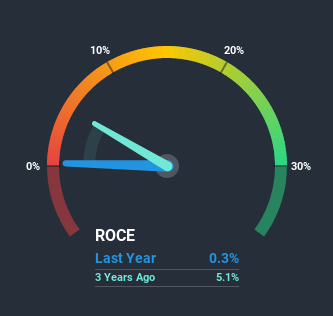- South Korea
- /
- Metals and Mining
- /
- KOSE:A004020
These Metrics Don't Make Hyundai Steel (KRX:004020) Look Too Strong

Ignoring the stock price of a company, what are the underlying trends that tell us a business is past the growth phase? More often than not, we'll see a declining return on capital employed (ROCE) and a declining amount of capital employed. This indicates to us that the business is not only shrinking the size of its net assets, but its returns are falling as well. And from a first read, things don't look too good at Hyundai Steel (KRX:004020), so let's see why.
What is Return On Capital Employed (ROCE)?
For those that aren't sure what ROCE is, it measures the amount of pre-tax profits a company can generate from the capital employed in its business. The formula for this calculation on Hyundai Steel is:
Return on Capital Employed = Earnings Before Interest and Tax (EBIT) ÷ (Total Assets - Current Liabilities)
0.0025 = ₩73b ÷ (₩35t - ₩6.1t) (Based on the trailing twelve months to December 2020).
Therefore, Hyundai Steel has an ROCE of 0.3%. In absolute terms, that's a low return and it also under-performs the Metals and Mining industry average of 4.1%.
Check out our latest analysis for Hyundai Steel

In the above chart we have measured Hyundai Steel's prior ROCE against its prior performance, but the future is arguably more important. If you'd like, you can check out the forecasts from the analysts covering Hyundai Steel here for free.
What The Trend Of ROCE Can Tell Us
We are a bit worried about the trend of returns on capital at Hyundai Steel. Unfortunately the returns on capital have diminished from the 5.8% that they were earning five years ago. And on the capital employed front, the business is utilizing roughly the same amount of capital as it was back then. Companies that exhibit these attributes tend to not be shrinking, but they can be mature and facing pressure on their margins from competition. If these trends continue, we wouldn't expect Hyundai Steel to turn into a multi-bagger.
The Key Takeaway
In summary, it's unfortunate that Hyundai Steel is generating lower returns from the same amount of capital. It should come as no surprise then that the stock has fallen 15% over the last five years, so it looks like investors are recognizing these changes. That being the case, unless the underlying trends revert to a more positive trajectory, we'd consider looking elsewhere.
Hyundai Steel does have some risks though, and we've spotted 2 warning signs for Hyundai Steel that you might be interested in.
While Hyundai Steel isn't earning the highest return, check out this free list of companies that are earning high returns on equity with solid balance sheets.
If you decide to trade Hyundai Steel, use the lowest-cost* platform that is rated #1 Overall by Barron’s, Interactive Brokers. Trade stocks, options, futures, forex, bonds and funds on 135 markets, all from a single integrated account. Promoted
Valuation is complex, but we're here to simplify it.
Discover if Hyundai Steel might be undervalued or overvalued with our detailed analysis, featuring fair value estimates, potential risks, dividends, insider trades, and its financial condition.
Access Free AnalysisThis article by Simply Wall St is general in nature. It does not constitute a recommendation to buy or sell any stock, and does not take account of your objectives, or your financial situation. We aim to bring you long-term focused analysis driven by fundamental data. Note that our analysis may not factor in the latest price-sensitive company announcements or qualitative material. Simply Wall St has no position in any stocks mentioned.
*Interactive Brokers Rated Lowest Cost Broker by StockBrokers.com Annual Online Review 2020
Have feedback on this article? Concerned about the content? Get in touch with us directly. Alternatively, email editorial-team (at) simplywallst.com.
About KOSE:A004020
Hyundai Steel
Engages in the manufacture and sale of steel and other industrial metal products in Korea, rest of Asia, the United States, and Europe.
Adequate balance sheet and fair value.
Similar Companies
Market Insights
Community Narratives



